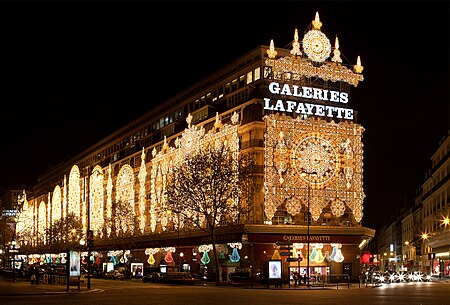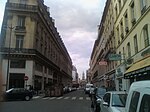Galeries Lafayette
1912 establishments in FranceArt Nouveau architecture in ParisArt Nouveau retail buildingsBuildings and structures in the 9th arrondissement of ParisCommercial buildings completed in 1912 ... and 6 more
Companies acquired from Jews under Nazi ruleDepartment stores of FranceFood hallsRetail companies established in 1912Retail companies of FranceShops in Paris

The Galeries Lafayette (French pronunciation: [ɡalʁi lafajɛt]) is an upmarket French department store chain, the biggest in Europe. Its flagship store is on Boulevard Haussmann in the 9th arrondissement of Paris but it now operates in a number of other locations in France and other countries. In 2019, Galeries Lafayette recorded earnings of over five billion euros. It is a part of the company Groupe Galeries Lafayette and has been a member of the International Association of department stores since 1960.
Excerpt from the Wikipedia article Galeries Lafayette (License: CC BY-SA 3.0, Authors, Images).Galeries Lafayette
Boulevard Haussmann, Paris 9th Arrondissement (Paris)
Geographical coordinates (GPS) Address Nearby Places Show on map
Geographical coordinates (GPS)
| Latitude | Longitude |
|---|---|
| N 48.873333333333 ° | E 2.3319444444444 ° |
Address
La Terasse des Galeries Lafayette
Boulevard Haussmann
75009 Paris, 9th Arrondissement (Paris)
Ile-de-France, France
Open on Google Maps









